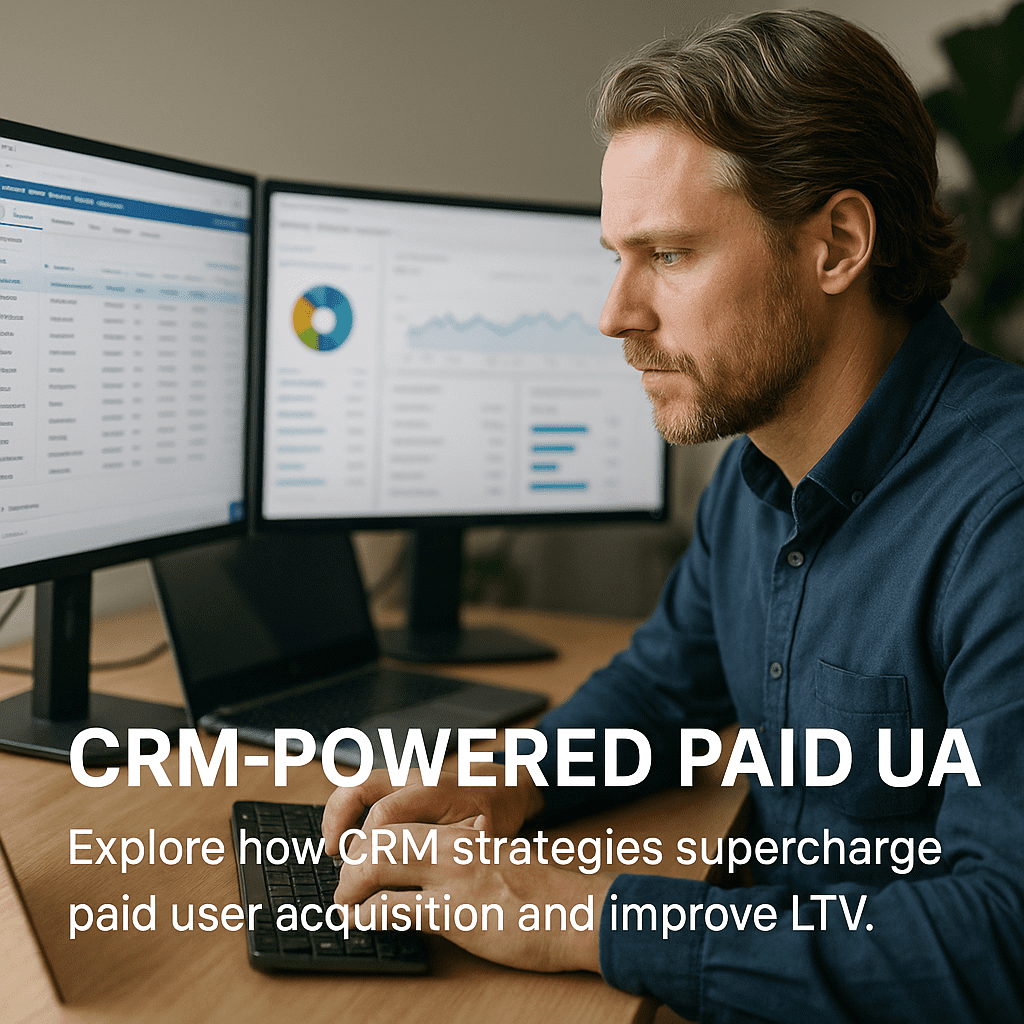
CRM-Powered Paid UA: Supercharging User Acquisition for Maximum LTV
In today’s saturated app marketplace, acquiring users is merely the first step—transforming those installs into high-value, long-term customers is where the real challenge lies. By combining a robust Customer Relationship Management (CRM) system with targeted Paid User Acquisition (UA), growth teams can unlock data-driven insights, personalize engagement at scale, and boost lifetime value (LTV) while reducing overall acquisition costs.
The Value of Integrating CRM with Paid UA
Paid UA campaigns excel at driving volume, but without ongoing engagement and retention tactics, acquisition budgets can be wasted on one-time users. A tightly integrated CRM closes that loop by:
- Centralizing user data from each paid channel
- Segmenting audiences for personalized messaging
- Automating workflows to drive onboarding, cross-sells, and re-engagement
- Measuring true ROI via metrics like LTV and Return on Ad Spend (ROAS)
According to Business of Apps Data, the average mobile app loses 77% of its daily active users within the first three days—underscoring the critical need for post-install engagement.
Key CRM Strategies to Amplify Paid UA
1. Advanced Segmentation and Dynamic Personalization
Generic messaging yields generic results. By leveraging CRM attributes—such as acquisition source, in-app behavior, and purchase history—marketers can craft segmented campaigns that resonate with each group:
- Social-acquired users (Facebook, Instagram) respond well to community-building incentives like referral bonuses or limited-time invites.
- Search-acquired users (Google Ads) often have higher purchase intent; offer them tailored discounts based on their search queries.
- Organic users can be nurtured toward premium features with educational drip campaigns.
Platforms such as Admiral Media’s user acquisition strategies have demonstrated 25% higher conversion rates by activating these personalization engines from day one.
2. Cross-Channel Orchestration
Modern consumers shift fluidly between channels. A CRM that supports email, SMS, push notifications, and in-app messaging ensures each user journey is cohesive:
- If a user abandons onboarding, an automated email reminder can follow up within an hour.
- Unopened emails trigger a sequenced SMS alert, reinforcing app benefits or offering exclusive content.
- High-value segments receive personalized push notifications highlighting new features aligned to their interests.
This omnichannel approach not only recovers drop-offs but also maximizes spend on retargeting ads by focusing on engaged audiences.
3. Data-Driven Creative and Audience Testing
Rather than relying on platform defaults, a CRM consolidates performance data across UA sources—Facebook, Google, Apple Search Ads—so marketers can:
- Identify top-performing creative variants by segment
- Allocate budget dynamically to high-ROI channels
- Iterate visuals and copy based on real-time engagement metrics
For example, a travel booking app using this method saw a 30% increase in ROAS by shifting budget from generic prospecting to lookalike audiences built from existing high-LTV customers.
Driving Higher-Value Installs with CRM Insights
Identifying and Targeting High-Value Profiles
Not all users are created equal. Conducting an RFM analysis (Recency, Frequency, Monetary) within your CRM allows you to pinpoint your most profitable cohorts. Key steps include:
- Extract the top 20% of customers by total spend and session frequency.
- Analyze demographic and behavioral trends: geography, device type, referral source.
- Build lookalike audiences on ad networks to target new users matching these attributes.
By focusing paid UA on these high-propensity profiles, app marketers routinely see CPA reductions of 15–25% and a proportional lift in early-stage LTV.
Automated Lead Management and Conversion
Every ad click or form submission becomes a CRM lead, instantly routed to the appropriate sales or success team. Automated lead scoring and task assignment ensure:
- No high-intent leads slip through gaps
- Follow-ups occur within SLA windows, increasing conversion odds
- Full visibility across the funnel, from ad touchpoint to subscription or purchase
Smart Retargeting During Peak Windows
Seasonal events and promotions demand precision. A CRM-powered retargeting suite can:
- Segment users who visited discount pages but didn’t complete checkout
- Trigger flash-sale alerts via push or email to reignite interest
- Adjust bid multipliers on paid channels only for high-intent segments
During last year’s holiday season, one e-commerce app increased holiday-period ROAS by 40% through CRM-driven retargeting workflows.
Measuring Success: Beyond Installs to True ROI
Critical KPIs for CRM-Enhanced UA
While CPI and CPA remain important, true performance requires richer metrics:
- Customer Lifetime Value (LTV): Aggregate revenue per user over time
- Return on Ad Spend (ROAS): Revenue divided by ad spend, benchmarked by campaign
- Day 7/Day 30 Retention Rates: Stickiness indicators beyond initial install
- Conversion Rate by Source: Channel-specific customer journey performance
Tools like GA4 Lifetime Value Metrics help correlate in-app behavior with acquisition channels, revealing pockets of untapped opportunity.
Empowering Continuous Optimization
Integrating campaign analytics into your CRM dashboard creates a single source of truth. Automated reports highlight shifts in performance by segment, enabling rapid pivots—whether reallocating budget to a top-performing ad set or pausing underperforming creatives.
Timing Your CRM-Powered Paid UA Push
New App Launches
At launch, the dual momentum of paid UA and CRM-enabled onboarding dramatically accelerates learnings. Early installs feed your CRM with behavioral data, fueling A/B tests for messaging, features and pricing models.
Competitive Market Positioning
With over 5.5 million apps available as of Q4 2023 (Business of Apps), standing out requires both visibility and stickiness. CRM-enhanced paid UA gives you an edge by activating high-intent segments and reducing churn.
Seasonal and Event-Driven Campaigns
Whether it’s Black Friday, summer promotions, or app-store feature opportunities, CRM workflows ensure every new install receives a tailored welcome and incentive—maximizing both install velocity and post-install engagement.
Implementing Your CRM-Powered UA Roadmap
Follow these five steps to build a sustainable growth machine:
1. Integrate Systems and Data Sources
Connect your CRM to ad networks (Facebook, Google, Apple Search Ads) and measurement platforms (Adjust, Amplitude). Unified data enables rapid audience creation and campaign customization.
2. Define High-Value Segments
Leverage historical data to create user personas and lookalikes. These personas inform ad creative, bid strategies, and onboarding flows.
3. Design Automated Workflows
Map the ideal user journey—from ad click to subscription—and build automated touchpoints: welcome messages, feature tours, cross-sell prompts, and loyalty rewards.
4. Align Cross-Functional Teams
Break down silos between marketing, product, and customer success. With shared CRM insights, each team speaks the same language and delivers consistent brand experiences.
5. Iterate with Data-Backed Decisions
Review weekly dashboards for shifts in LTV, ROAS, and retention. Optimize audiences, creatives, and workflows in response to emerging trends.
Conclusion: The Future of CRM-Powered UA
In an increasingly competitive app ecosystem, the most successful growth engines will be those that marry acquisition velocity with deep, data-driven engagement. By embedding CRM at the heart of your paid UA strategy, you:
- Acquire higher-quality users
- Accelerate onboarding and activation
- Maximize LTV while driving down CPA
- Create sustainable, repeatable growth loops
For a turnkey approach to CRM-powered user acquisition, partner with Admiral Media’s services and start turning every install into a lasting customer relationship.
